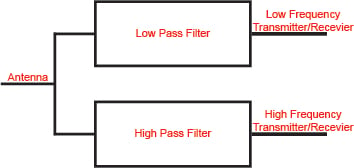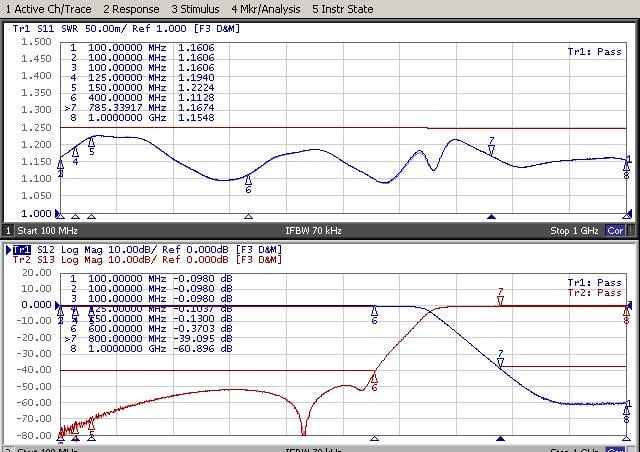The typical use of a diplexer (three port device) enables source transmitters operating on two separate frequencies to use the same antenna. In other applications, the diplexer allows a single antenna to transmit and receive on discreet frequencies. Additionally, a diplexer will provide the ability for an antenna to transmit and receive simultaneously.
In all cases, the diplexer's ability to reject or isolate these two signals despite the common port they share is what makes it such a special device. This is achieved within the diplexer by using high pass and low pass filters connected to a common input port that combine signals to or from an antenna while isolating the two independent signals.
Basic Diplexer Concepts
While there are various types of RF diplexers, all designs require the use of a filter. The discreet filter design provides the different transmitter and receiver signals to be separated according to each specific frequency allocation. Band pass filters can be utilized but the best rejection is realized through the use a low pass and a high pass filter. Due to this configuration, two things occur: all signals with frequencies below the cutoff frequency of the low pass filter are directed to port 2 and all signals above the cutoff frequency of the high pass filter are directed to port 3. Since there is no path between port 2 and port 3, signals that pass through the low pass filter will not be able to pass through the high pass filter and vice versa. The additional benefit of the low/high pass diplexer is that the line or load impedance remains matched to the internal impedance of the receiver or transmitter; it remains constant despite the load impedance connected to the other port.

Basic Concept of a High/Low Pass Filter Diplexer
Diplexer Requirements
When designing an RF diplexer there are many factors to consider. Of the most critical is the degree of isolation or rejection required between the high and low frequency transmitter/receiver ports.
The lowest diplexer performance envelope is required when a diplexer is used in a receive mode only, for example when TV and FM signals are combined. The rejection requirement is low, perhaps 15dB of rejection, so a fairly simple filter set would provide adequate isolation to ensure the receivers see the correct impedance and low insertion loss.
A step up in performance is required where the diplexer is used in a transmit mode only. It is important to minimize the transmit power from one source from being fed back to that of the second source. Any power that is allowed back into the output of an amplifier or transmitter will likely cause intermodulation distortion (IMD) and cause interference. While it is important that each amplifier sees the correct impedance individually, it is even more important that the port 2 transmitter does not affect the impedance seen by the transmitter on port 3. In this case, isolation levels of 40-50dB between the transmitter ports may be necessary.
The highest performing diplexer application is where one port is used for transmitting when the other port is being used for receiving in a simultaneous mode. Extremely high levels of rejection are required between the ports to ensure that the minimum level of the transmitter power is fed back to the receiver. If high levels of the amplifier signal reach the receiver, damage can occur. The levels of isolation required for these types of applications may reach 100dB.

Example of Radio Frequencies
Band Pass Filters
Where narrow bandwidth diplexers are specified, it is possible to create a design using band pass filters. This configuration can be used where wide bandwidth is not required on a transmit and/or receive port. As an commercial example for use of this type of diplexer are cellular repeater applications that receive on one channel and simultaneously transmit on another.
Summary
While diplexers are used in a broad range of service applications, they are a critical piece of hardware. Military communication antenna systems and cellular transmissions, though very different, would be significantly more complicated without the use of a diplexer. Without the ability to allow antennas to be shared by multiple transmitters, most of the existing broadcast and communication systems as we know them today would be more expensive and less efficient.

















